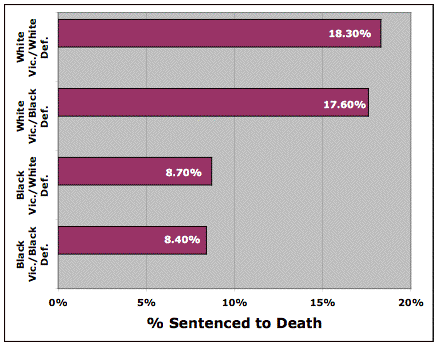

THE DIFFERENCE BETWEEN LIFE AND DEATH:
Comprehensive Ohio Study Concludes That Who Lives and Who Dies Depends On Race, Geography and Plea Bargains
In a major study of 1,936 indictments reported to the Ohio Supreme Court by Ohio counties with capital cases from October 1981 through 2002, the Associated Press found that capital punishment has been applied in an uneven and often arbitrary fashion.
- Defendants facing a death penalty charge for killing a white person were twice as likely to be sentenced to death than defendants charged with killing a black person. This gross disparity in capital sentencing sends a message that the taking of a white life is more serious than the taking of a black life.
Rate Of Death Sentencing For Defendants Charged With Killing White Versus Black Victims
- Defendants most likely to get the death penalty were those who killed white victims, regardless of the race of the defendant:
-
- Of 693 white victim cases with white defendants:
- 127 were given the death penalty (18.3%)
- Of 693 white victim cases with white defendants:
-
- Of 353 white victim cases with black defendants
- 62 were sentenced to death (17.6%).
- 62 were sentenced to death (17.6%).
- Of 353 white victim cases with black defendants
BUT
- Defendants who killed black victims were the least likely to get the death penalty, regardless of the race of the defendant
-
- Of 752 black victim cases with black defendants
- 63 were sentenced to death (8.4%)
- Of 752 black victim cases with black defendants
-
- Of 46 black victim cases with white defendants
-
- 4 were sentenced to death (8.7%).
- Of 46 black victim cases with white defendants
Death Sentencing Rates Comparing Race of Victims and Defendants
Nearly half of the cases in which the state said it was seeking the death penalty ended with a plea bargain and a sentence less than death. Many of these were among the most serious crimes, including 31 cases in which the crime involved two or more victims, and 25 cases in which the crime involved at least three victims.
Plea Bargaining in Capital Cases
Geography appeared to play a major role in who was sentenced to death. For example, in Cuyahoga County (including the city of Cleveland) 8.5% of capitally charged defendants received a death sentence but in Hamilton County (including the city of Cincinnati), 43% received a death sentence.
Rate of Death Sentencing For Defendants Charged With Capital Crimes in Cuyahoga Versus Hamilton County
The Associated Press reported the findings of its detailed study in a three-part series, noting that:
1. Capital punishment is applied unequally in Ohio, with race-of-victim, geography, and plea-bargains affecting death sentencing;
2. Capital cases are expensive and are squeezing budgets in smaller counties; and
3. Disparities exist in the resolution of death penalty cases in Ohio, when three-judge panels spare the life of only one of two defendants convicted of strikingly similar crimes.
(Associated Press, May 5, 2005).
See the full series:
Andrew Welsh-Huggins, “Death Penalty Unequal,” Associated Press, May 7, 2005.
Kate Roberts, “Capital Cases Hard for Smaller Counties,” Associated Press, May 8, 2005
John Seewer, “Two Killers; One Spared,” Associated Press, May 9, 2005.
See Race and Studies.



